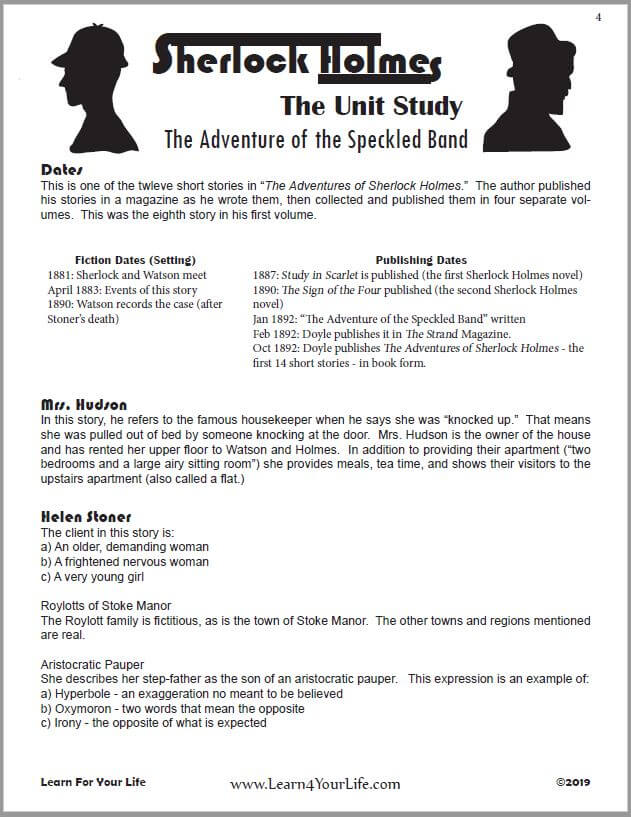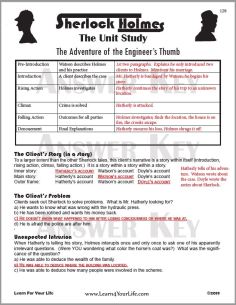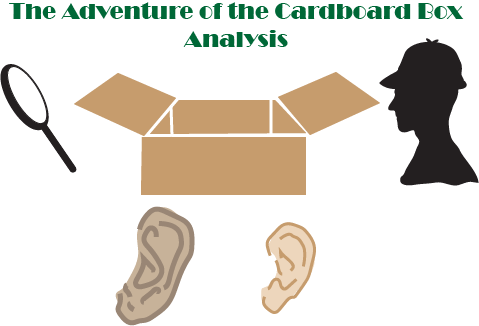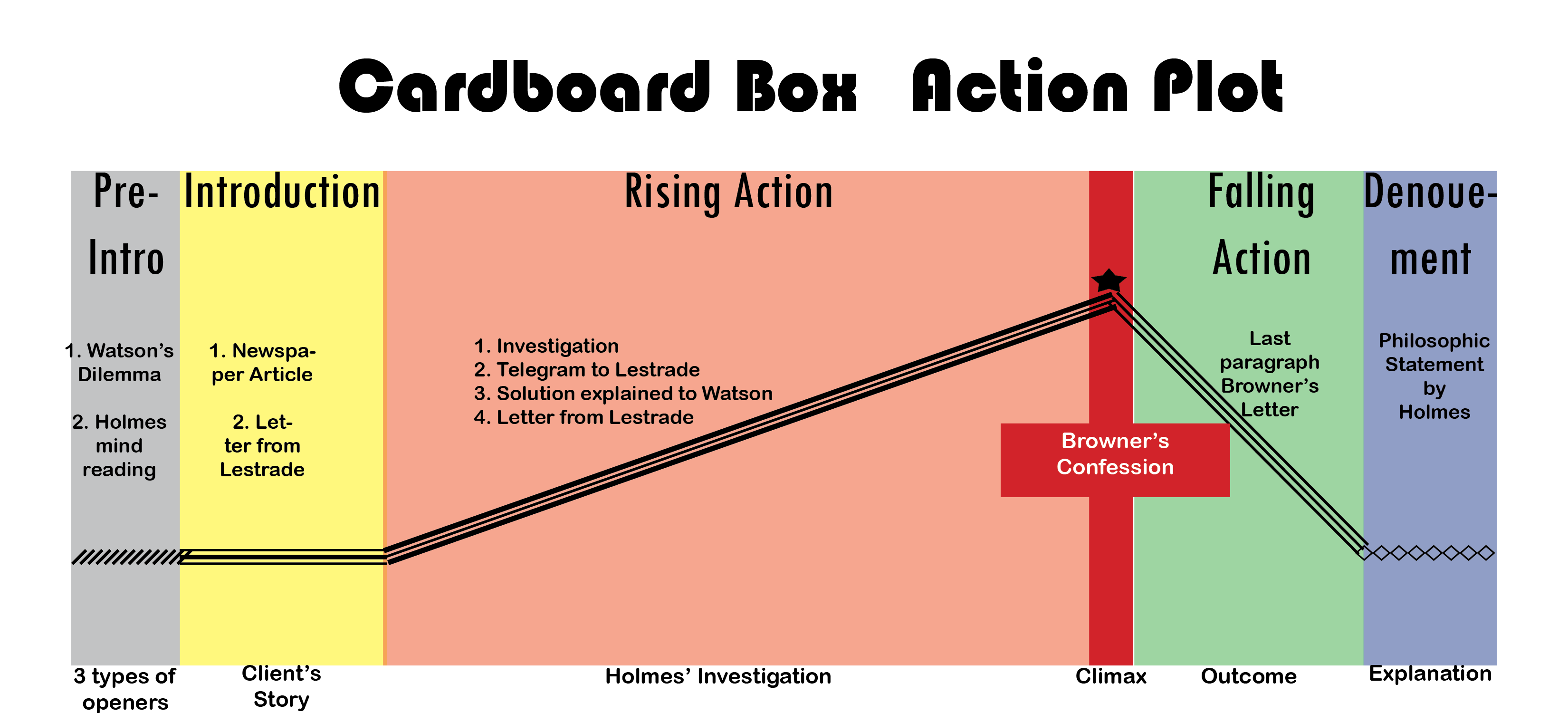Adventure of the Cardboard Box
#D-14 CARD
Is the cardboard box merely a practical joke or a symbol of the misery of human despair?
Analyze the themes and literary elements in Arthur Conan Doyle's story.
In this series the unique features of Sherlock Holmes short stories are discussed. We do not summarize the plot on this page, assuming that each reader has already read the actual story.
Dating of the Story
- Setting of the story: hot August day (unspecified year)
- Date recorded by Watson: not specified but according to Watson's last sentence in His Last Bow preface this is one of the stories "which have lain long in my portfolio."
- First published by Doyle in The Strand and Harper Weely: January 1893
- Published in Book Form: 1917 His Law Bow - the fourth collection of short stories
Story Opening
We hope our readers are having fun diagnosing the types of story openers in the Sherlock canon. The Adventure of the Cardboard Box is a double hitter with two of the three different openers.Watson's Dilemna
The first paragraph is classic as one of "Watson's Dilemmas."- -ABC; He prefers to select those with a minimum of sensationalism and instead write about
- XYZ: those with a fair field for his talents.
- Watson then warns us this case will be a strange though peculiarly terrible chain or events.
- Look in the section below to see how the pronoucement/fulfillment ended.
Baker Street Scene
After learning via Watson's Dilemma that we are about to embark on a sensational case, we are treated to a second type of Sherlock Starter: a Baker Street Scene. Holmes is lounging on the sofa, reading and re-reading a letter that opens this case. But before explaining the case, a lengthy dialogue ensues as Holmes amazes Watson by reading his thoughts and agreeing that war is a terrible thing.Two aspects of the dialogue interest us. First, the sensationalism of Holmes' mind-reading ability, which he elucidates to his friend. A similar mind-reading event occurs at the beginning of The Adventure of the Dancing Men.
Second, Holmes' opening statement is about the misery of war. Death and misery, as well as sensationalism, are themes in this particular short story. Therefore Doyle tied the pre-introductory pronouncement, the themes, and the ending together with his mind-reading scenario.
Pre-Introductory Pronouncement and FulFillment
So how does this story accomplish the the pronouncement and fulfillments in Sherlock Holmes stories?The Pronouncement
The two pronouncements mirror the two story starters mentioned in the section above:- A sensational case
- Requires mind-reading abilities
The Fulfillment
So what do we find at the end of the story?- Yes, it is a sensational case (gruesome mystery, family feud, romance, murder confession.)
- Does it prove Sherlock's abilities? Not according to Holmes in his letter to Lestrade:
"I should prefer that you do not mention my name at all in connection with the case as I choose to be only associated with those crimes which present some difficulty in their solution."
Lestrade himself concluded that "the affair proves, as I always thought it would, to be an extremely simple one"
- Sherlock, of course, questions why Lestrade should have called him in if it was that simple. Good point, Sherlock.
- This, therefore, can be considered +ABC/-XYZ
- Mental abilities - In his explanation of the case Sherlock states: ...we have been compelled to reason backward from effects to causes.
- And speaking of mental capacity, one can say that the mental anguish of Mr. Browner stands in contrast to Sherlock's calm, collected mental powers. Of course, Sherlock isn't guilty of murder either.
Action Plot
This story follows the basic Sherlock Holmes action plot with only a small deviation.- The pre-introduction is longer than usual (as discussed above in story opening.) It fills two or three pages rather than the typical one or two paragraphs.
- The introduction of the case is not done by a client but by a review of the newspaper article and letter from Lestrade.
- The pre-introduction and introduction then flow smoothly into the case and are closely tied to it.
- Usually Holmes investigates in the rising action phase and announces the solution at the climax. The action plot in this story deviates from his usual template in the following ways:
- Rising Action
- Investigation at Susan's house (He determines there was a murder of her sister by her husband per clues above.)
- Investigation at Sarah's (He determines that Sarah was the intended recipient and is ill from the account.)
- Holmes informs Lestrade where Browning is so he can arrest him.
- He then explains his solution to Watson. (Usually this is in the falling action. But here we are still in the rising action phase.)
- Letter from Lestrade is read:
- back flashes to Browner's capture and arrest
- Browner confessed to the murder
- An exact copy of the confession is included in text
- This confession of Browner continues the Rising Action
- The Climax is within the confession.
- Falling Action - Last paragraph of Browner's letter
- Denouement - Holmes' philosophic statement
Themes
Two themes stand out: Misery and sensationalism.In this case, Doyle tied the themes with the pre-introduction and denouement (he didn't do that so directly in most of his stories.)
Sherlock's Deductions
Here is a list of things our proficient investigator deduced:- Tarred string
- Knot - sailor sent the package
- Miss S. Cushing - package sent to the wrong address
- Coarse salt: Ears are not preserved in the preservatives used in the medical world
- Ears cut with blunt instrument
- Two different ears: a female and a male victim
- Male ear was pierced: a sailor
- Shape of Miss Cushing's ear - the female victim is a relative
- Portrait of three women: Miss Cushing has two sisters
- Picture of younger sister and steward: ????????
- Sarah moved out of Susan's house two months ago - sent to Sarah, remaining sister is victim
Closer Look At Holmes
Workaholic Detective
What insights does this tale give us into Sherlock Holmes' personality?Neither the country, nor the sea presented the slightest attraction to him. He loved to lie in the very centre of five million people, with his filaments stretching out and running through them, responsive to every little rumour of suspicion of unsolved crime. Appreciation of nature found no place among his many gifts, and his only change was when he turned his mind from the evil-doer of the town to track down his brother of the country.This does, somewhat, contradict Holmes' own statement that he would like to retire from the world of crime and investigate nature, which he did do at the end of his career. Nonetheless, Doctor Watson notes that a country vacation had no attraction for the work-a-holic who avoided vacationing until forced to do so by his health.
The Musician
He bought his 500 guinea Stradivarious violin for 55 shillings and knew multiple facts about Paganini.Writer
He added two articles in Anthropological Journal about the distinctive features of each person's ear (somewhat like fingerprints)to his list of articles written by Sherlock Holmes.Fictitous Transparency
Fictitious Transparency refes to the occasional reference by Holmes to Watson's publications of their cases. In this instance, Holmes asks, "Can you rise superior to the heat and run down to Croydon with me on the off chance of a case for your annals?"Hmmm, was Holmes merely being glib, or was Watson's participation in cases motivated by a desire to write about them?
Antiquated Vocabulary
- Antimacassar - a piece of cloth that covers the back or arms of a chair to protect the original fabric from wear and tear.
- Blue Ribbon - a ribbon worn as a pledge not to drink (a pre-cursor to AA you might consider it)
Ending
This is not a typical Sherlock Holmes ending. Rather than flippant, we see a somber Holmes close his notebook and the case:"What object is served by this circle of misery and violence and fear? It must tend to some end, or else our universe is ruled by chance, which is unthinkable. But what end? There is the great standing perennial problem to which human reason is as far from an answer as ever?"
Baker Street Treasure Hunt
A newly framed picture of General Gordon and an unframed picture of Henry Ward Beecher are part of our Baker Street Treasure Hunt for this story.The unit study below analyzes eight of the most popular Sherlock Holmes stories. The Adventure of the Cardboard Box is not one of the eight in this unit study.
Buy Sherlock Holmes: The Unit Study


Student Guide AND Teacher's Answer Key Included
$2.99 Download - 183 pages
Eight of the most popular tales demonstrate how to investigate a detective story.
![]()
Sherlock Holmes Pages
A catalog of our pages on Sherlock Holmes.
About Our Site
Hands-On Learning

































